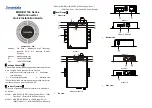
FR500A&FR510A Series Vector Control Inverter
- 128 -
0
ON
Negative
1
OFF
Negative
1
ON
Positive
Positive adjustment:
When feedback signal is smaller than PID setting, output frequency of the drive will rise to reach
PID balance.
When feedback signal is bigger than PID setting, output frequency of the drive will drop to reach
PID balance.
Negative adjustment:
When feedback signal is smaller than PID setting, output frequency of the drive will drop to reach
PID balance.
When feedback signal is bigger than PID setting, output frequency of the drive will rise to reach
PID balance.
F13.05
Filtering time of PID setting
Range:0.000
~
10.000s
Default:0.000s
F13.06
Filtering time of PID
feedback
Range:0.000
~
10.000s
Default:0.000s
F13.07
Filtering time of PID output
Range:0.000
~
10.000s
Default:0.000s
Set the filtering time of PID setting, feedback and output.
F13.08
Proportional gain Kp1
Range:0.0
~
100.0
Default:1.0
F13.09
Integration time Ti1
Range:0.01
~
10.00s
Default:0.10s
F13.10
Differential time Td1
Range:0.000
~
10.000s
Default:0.000s
Proportional gain Kp1:
It decides the regulating intensity of the PID regulator. The higher the Kp1 is, the larger the
regulating intensity is. The value 100.0 indicates when the deviation between PID feedback and PID
setting is 100.0%; the adjustment amplitude of the PID regulator on the output frequency reference is
the maximum frequency.
Integral time Ti1:
It decides the integral regulating intensity. The shorter the integral time is, the larger the regulating
intensity is. When the deviation between PID feedback and PID setting is 100.0%, the integral
regulator performs continuous adjustment for the time set in FA-06. Then the adjustment amplitude
reaches the maximum frequency.
Differential time Td1:
It decides the regulating intensity of the PID regulator on the deviation change. The longer the
differential time is, the larger the regulating intensity is. Differential time is the time within which the
feedback value change reaches 100.0%, and then the adjustment amplitude reaches the maximum
frequency.
F13.11
Proportional gain Kp2
Range:0.0
~
100.0
Default:1.0
F13.12
Integration time Ti2
Range:0.01
~
10.00s
Default:0.10s
F13.13
Differential time Td2
Range:0.000
~
10.000s
Default:0.000s
In some applications, PID parameters switchover is required when one group of PID parameters
cannot satisfy the requirement of the whole running process.These parameters are used for
switchover between two groups of PID parameters. Regulator parameters F13.11 to F13.13 are set in
the same way as F13.08 to F13.10.
F13.14
PID parameter switch
Range:0
~
2
Default: 0
F13.15
PID parameter switchover
deviation 1
Range:0.0
~
100.0%
Default:20.0%
F13.16
PID parameter switchover
deviation 2
Range:0.0
~
100.0%
Default:80.0%
Process PID is provided with two groups of proportional, integral and differential parameters,
which is set by this parameter.
0: No switch, determined by parameters Kp1, Ti1 and Td1
Always determined by Kp1, Ti1 and Td1 set at F13.08 to F13.10.
1: Auto switched on the basis of input offset
When the offset between setting and feedback is less than the set value of F13.15, PID
adjustment is determined by Kp1, Ti1 and Td1. When the offset between setting and feedback is















































